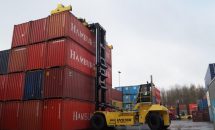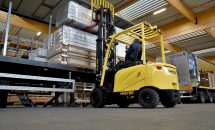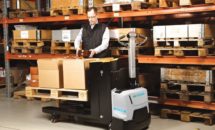Hyster has launched a new 2 tonne capacity pedestrian stacker for stacking and retrieving loads from racking up to 4m high. The S2.0 model completes the range of seven other stackers previously launched in the summer of 2016.
Reliable, tough and compact, according to the manufacturer the S2.0 offers among the lowest energy consumption levels in its class. With fast acceleration at the full 2 tonne capacity and travel speeds of up to 6 km/h, it gives increased performance and productivity over short and medium travel distances. Controlled changes in travel direction also help to increase cycle time, particularly in areas with incoming or outgoing goods where pallets are transported to/from the receiving dock or from marshalling areas to storage.
Some order picking operations will also benefit as forks can be adjusted to an ergonomic working height. When handling delicate loads, there is also separate fast and slow lift and lowering controls and operators have optimum visibility through the 2- stage mast.
The new stacker has a high level of parts commonality with the smaller stacker models and other Hyster products. Furthermore the robust chassis design, sealed transmission and a service interval of 3,000 hours (or 3 years) for hydraulic oil and filter changes, help contribute to a low cost of operation.
Side battery removal makes switching the battery quicker, in particular where there is a need to extend truck availability on multiple shifts.
Low energy consumption keeps the ongoing running costs under control and the stacker can be adapted to suit the load, floor type and other application challenges. Options include key pad access, cold store protection, load and drive wheel options, a range of fork lengths and widths and practical solutions such as a film roll holder, an A4 clipboard and drink holder.
Tags:
Hyster, Hyster S2.0, Stacker, Stackers, Warehouse truck, Warehouse trucks
Logistics and forwarding company Mönkemöller Speditio...

Hyster Europe has extended its range of electric count...

With the MDW and the MDE, UniCarriers is introducing a ...